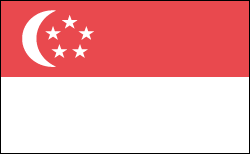SINGAPORE

Geography: The Republic of Singapore consists of the main island of Singapore, off the southern tip of the Malay Peninsula between the South China Sea and the Indian Ocean, and 58 nearby islands.
Government: Parliamentary republic.
History: Inhabitants of the Malaysian peninsula and the island of Singapore first migrated to the area between 2500 and 1500 B.C. ( see Malaysia). British and Dutch interest in the region grew with the spice trade, and the trading post of Singapore was founded in 1819 by Sir Stamford Raffles. It was made a separate Crown colony of Britain in 1946, when the former colony of the Straits Settlements was dissolved. The other two settlements on the peninsula—Penang and Malacca—became part of the Union of Malaya, and the small island of Labuan was transferred to North Borneo. The Cocos (or Keeling) Islands and Christmas Island were transferred to Australia in 1955 and in 1958, respectively.
Singapore attained full internal self-government in 1959, and Lee Kwan Yew, an economic visionary with an authoritarian streak, took the helm as prime minister. On Sept. 16, 1963, Singapore joined Malaya, Sabah (North Borneo), and Sarawak in the Federation of Malaysia. It withdrew from the federation on Aug. 9, 1965, and a month later proclaimed itself a republic.
Under Lee, Singapore developed into one of the cleanest, safest, and most economically prosperous cities in Asia. However, Singapore's strict rules of civil obedience also drew criticism from those who said the nation's prosperity was achieved at the expense of individual freedoms.
S. R. Nathan was declared president without an election when he was certified as the only candidate eligible to run in 1999 elections. In Aug. 2004, Lee Hsien Loong became the country's third prime minister since Singapore gained independence from Britain in 1965. Lee faced his first electoral challenge in May 2006. His People's Action Party (PAP) won 82 out of 84 seats in parliamentary elections.
In Singapore's May 2011 general election, the ruling People's Action Party was reelected with a majority of 81 to 6, which was the equivalent of 60% of the vote. This percentage was viewed as promising by the opposition, as it was significantly less than in the two previous elections. After the elections, prime minister Lee Hsien Loong uncharacteristically acknowledged mistakes and pledged a more efficient government in the future.
Following on the heels of the general election, August's presidential election saw a field of four candidates from which the ruling party's Tony Tan emerged victorious. Though favored to win, Tan's triumph was not exactly a landslide—the 7,000 vote margin was the equivalent of 35.2% of the vote.

Map of
Singapore
President: Tony Tan Keng Yam (2011)
Prime Minister: Lee Hsien Loong
(2004)
Land area: 241 sq mi (624 sq km); total
area: 267 sq mi (692.7 sq km)
Population (2014 est.): 5,567,301
(growth rate: 1.92%); birth rate: 8.1/1000; infant mortality rate:
2.53/1000; life expectancy: 84.38
Capital and largest city (2011 est.):
Singapore, 5,183,700.
Monetary unit: Singapore dollar
Languages:
Mandarin (official) 36.3%, English (official) 29.8%,
Malay (official) 11.9%, Hokkien 8.1%, Tamil (official) 4.4%, Cantonese
4.1%, Teochew 3.2%, other Indian languages 1.2%, other Chinese dialects
1.1%, other 1.1% (2010 est.)
Ethnicity/race:
Chinese 74.2%, Malay 13.3%, Indian 9.2%, other 3.3% (2013 est.)
Religions:
Buddhist 33.9%, Muslim 14.3%, Taoist 11.3%, Catholic 7.1%, Hindu 5.2%, other Christian 11%, other 0.7%, none 16.4% (2010 est.)
Literacy rate: 95.9% (2010 est.)
Economic summary: GDP/PPP (2013
est.): $339 billion; per capita $62,400. Real growth rate:
4.1%. Inflation: 5.2%. Unemployment: 1.9% (2013).
Arable land: 0.89%. Agriculture: orchids, vegetables; poultry, eggs; fish, ornamental fish. Labor
force: 3.444 million (2013 est.); agriculture 1.3%; industry 18.6%; services 80.1 (2013).
Industries: electronics, chemicals, financial services, oil
drilling equipment, petroleum refining, rubber processing and rubber
products, processed food and beverages, ship repair, offshore
platform construction, life sciences, entrepôt trade. Natural
resources: fish, deepwater ports. Exports:
$410.3 billion
(2013 est.): machinery and equipment (including electronics
and telecommunications), pharmaceuticals and other chemicals, refined
petroleum products, food and beverages. Imports: $373 billion (2013 est.):
machinery and equipment, mineral fuels, chemicals, foodstuffs, consumer goods.
Major trading partners: U.S., Malaysia, Hong Kong, China,
Japan, Indonesia, South Korea, Indonesia, Saudi Arabia, UAE, Australia (2012).
Member of Commonwealth of Nations
Communications: Telephones: main lines
in use: 1.99 million (2012); mobile cellular: 8.063 million (2012).
Radio broadcast stations: AM 0, FM 18 (2008). Television broadcast stations:
8 (2008). Televisions: 1.33 million (1997). Internet
Hosts: 1.96 million (2012). Internet users: 3.235
million (2009).
Transportation: Railways: total: 38.6
km. Highways: total: 3,425 km; paved: 3,425 km (including 161
km of expressways). Ports and harbors:
Singapore. Airports: 9 (2013).
International disputes: disputes
persist with Malaysia over deliveries of fresh water to Singapore,
Singapore's extensive land reclamation works, bridge construction, and
maritime boundaries in the Johor and Singapore Straits; in 2008, ICJ
awarded sovereignty of Pedra Branca (Pulau Batu Puteh/Horsburgh Island)
to Singapore, and Middle Rocks to Malaysia, but did not rule on maritime
regimes, boundaries, or disposition of South Ledge; Indonesia and
Singapore continue to work on finalization of their 1973 maritime
boundary agreement by defining unresolved areas north of Indonesia's
Batam Island; piracy remains a problem in the Malacca Strait.
-------------------- o --------------------
No comments:
Post a Comment